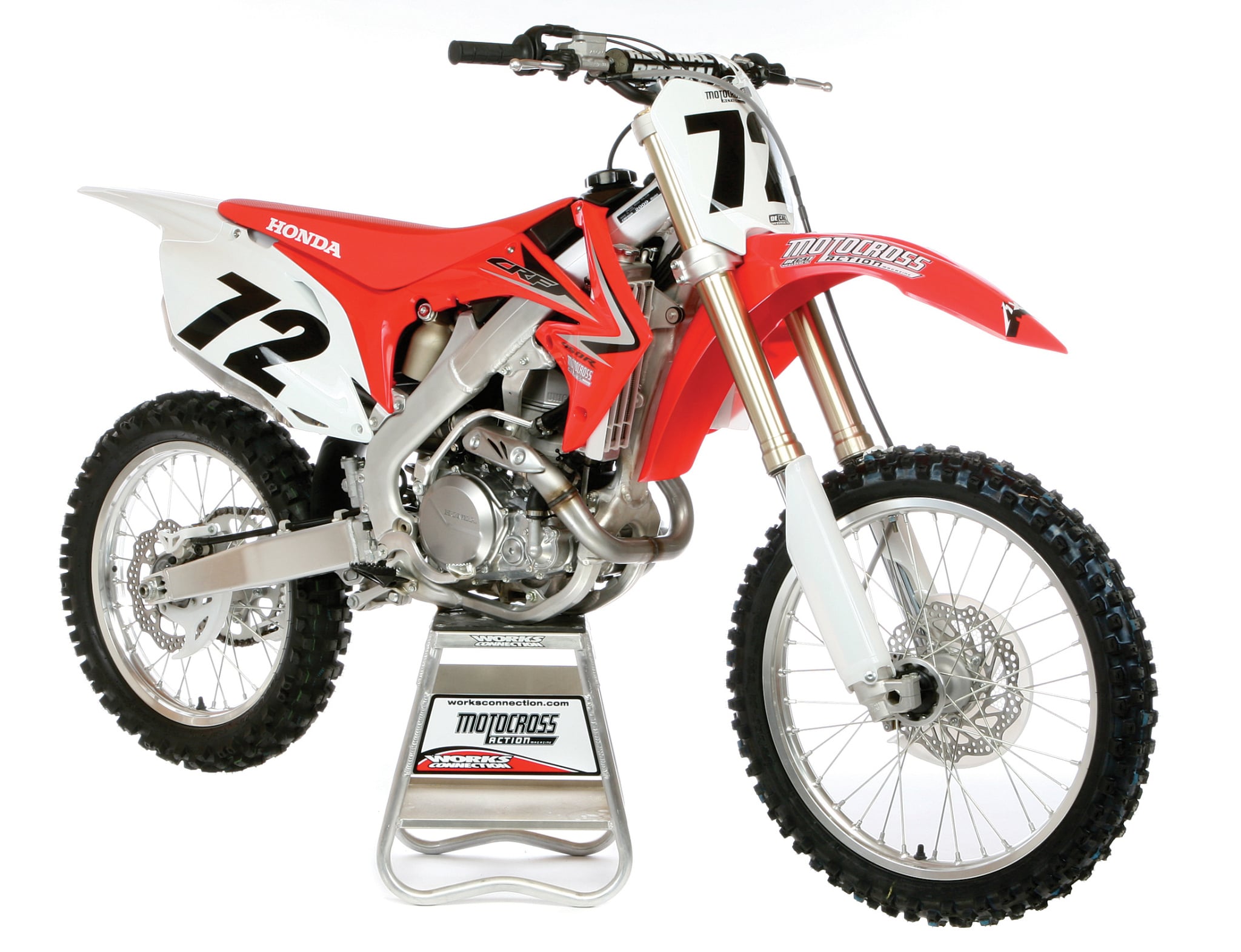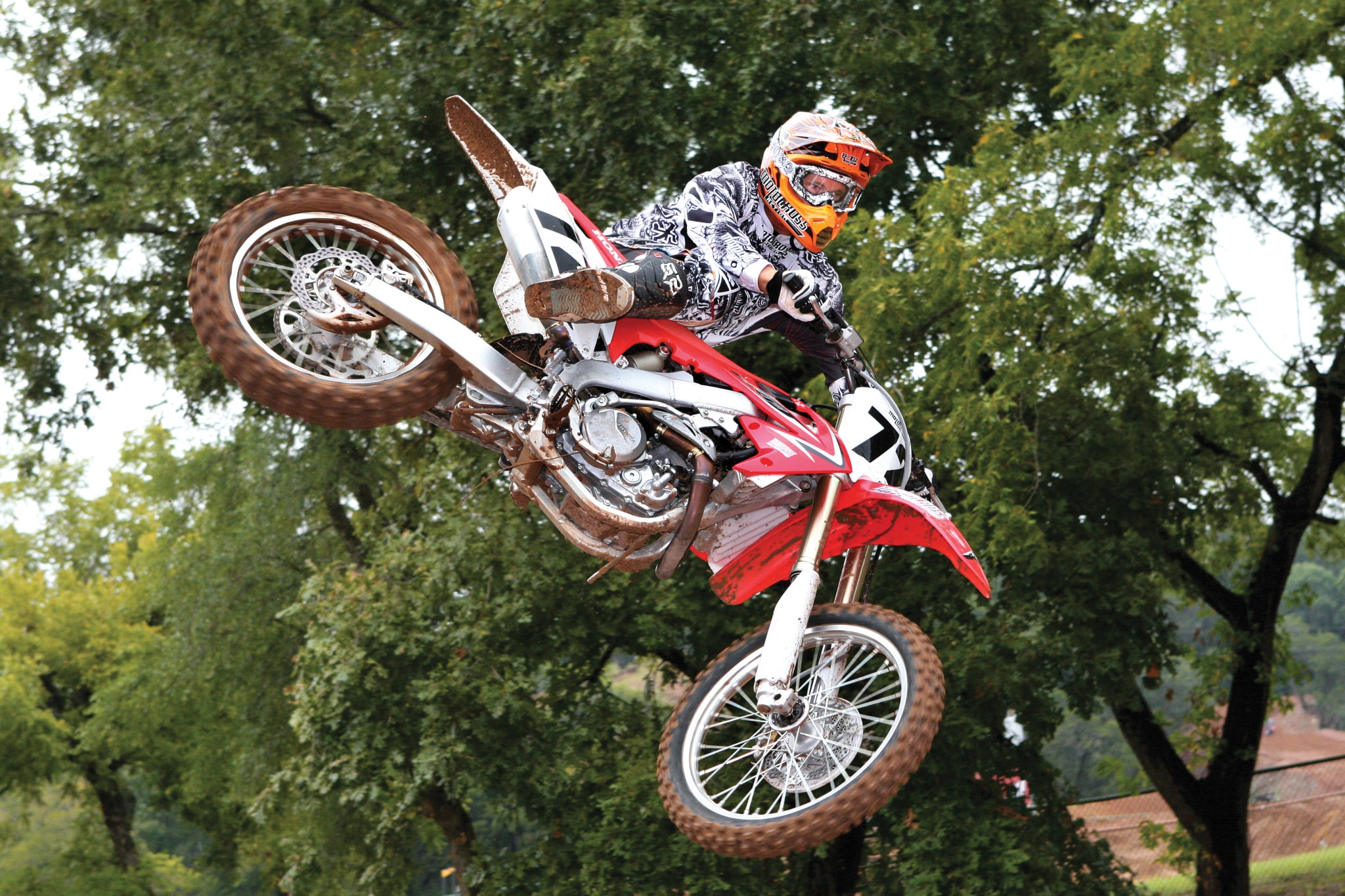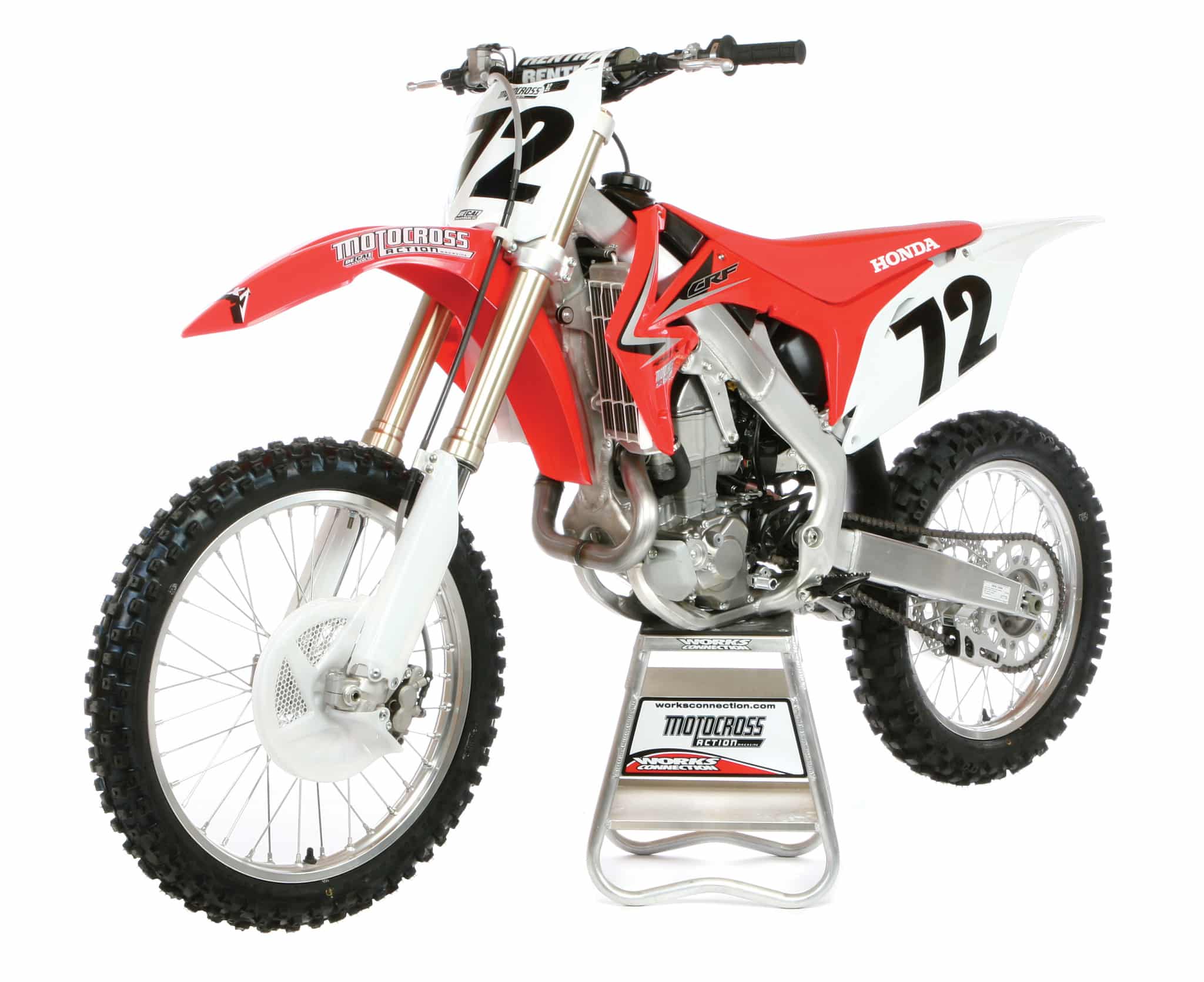MXA RETRO TEST: THE 2009 CRF450, THE WORST HONDA EVER MADE
 Once the 2009 Honda CRF450 reached 8200 rpm, where it made its peak horsepower, it stayed at that horsepower no matter how much you revved it. It has the flattest top-end powerband ever made.
Once the 2009 Honda CRF450 reached 8200 rpm, where it made its peak horsepower, it stayed at that horsepower no matter how much you revved it. It has the flattest top-end powerband ever made.
When a consumer decides to plunk down over eight grand on a product, it is in their best interest to try to learn as much as possible about their intended purchase. And so it is with the 2009 Honda CRF450. The all-new Honda has become the most eagerly anticipated and ballyhooed new model release in years.
One of the inherent problems that consumers face with a bike that engenders so much buzz is that it achieves folklore status before it is even ridden. Word of mouth, fueled by rumor, hope and exaggeration, elevates a machine made of metal and plastic to the epic proportions of Paul Bunyan and Babe the Blue Ox.
The MXA wrecking crew is naturally suspicious of any product that is “too good to be true.” We approached the 2009 Honda CRF450 just as we would any other test bike—with a fervent desire to tell the consumer exactly what he will be getting for his eight large. We think that this test will lay to rest any myths and expose the true performance of the machine.
Q: WHAT DID HONDA CHANGE ON THE 2009 CRF450?
A: Let’s make this easier by listing what Honda didn’t change from the 2008 model to the 2009 model: the hubs, handlebars and brakes are holdovers.
Q: WHY IS EVERYONE GETTING MISTY-EYED ABOUT FUEL INJECTION?
A: Although most people would be tempted to say fuel injection is the most important change on the 2009 CRF450, the MXA wrecking crew isn’t as enamored by EFI as the rest of the moto world. On a pure race bike, fuel injection is not better than a well-jetted carburetor. EFI doesn’t hit as hard in the middle, make as much horsepower on top or deliver excess fuel (when excess fuel is called for). It is just another way to get gasoline into the combustion chamber.
The big plus of fuel injection is that it is hands-off. There is no need to re-jet for altitude, temperature or humidity, because there are no jets. EFI will eventually replace carburetors and beat them in performance, but 2009 is not that year.
Q: WHAT’S SO UNIQUE ABOUT THE NEW CRF450 CHASSIS?
A: Most CRF450 owners are too young to remember the handling traits of the pre-’94 CRs. Suffice it to say that the 1994–2008 Hondas offered mere shadows of the turning prowess of the 1993 model. In fact, during his whole time at Team Honda (1993–1996), Jeremy McGrath only raced a 1993 Honda CR250. He hated the ’94, ’95 and ’96 frames, and rather than race them, “Super Mac” made Honda update his 1993 CR250 to look like the ’94, ’95 and ’96 models.
When the 1997 aluminum-framed CR250 was introduced, Jeremy knew the jig was up. He wouldn’t be able to race his trusty but rusty 1993 model in 1997 because its steel frame would be a dead giveaway that he wasn’t racing the 1997 model. Plus, the first aluminum-framed bike handled worse than any previous Honda. In the end, Jeremy didn’t have to deal with it, because he left Honda without having to throw a leg over the 1997 aluminum frame.
How does this pertain to the 2009 Honda CRF450? The MXA test riders think that the 2009 Honda CRF450 is worse than any previous Honda. Strange, because we think the 2008 CRF450 was the best Honda ever.
Q: WHAT DID HONDA DO TO THE 2009 CRF450 CHASSIS?
A: An incredible number of changes went into the 2009 frame, most of them stupid.
(1) The engine is completely redesigned to lower its overall height and position the crankshaft closer to the front wheel. This front-axle-to-crankshaft measurement is called the “front center,” and the shorter the front center, the more agile the chassis at turn-in. For 2009, the front center from the beloved 2008 CRF450 was reduced by 15mm.
(2) The swingarm is 18mm longer than in 2008, which moves the weight bias forward.
(3) The steering tube is moved back 10mm.
(4) Fork offset is reduced from 22mm to 20mm (fork offset in 2007 was 24mm). Trail is now 114.2mm (4.5 inches). Last year it was 111.4mm (4.3 inches).
(5) The frame’s head angle has been steepened from 26.76 degrees to 26.52 degrees.
(6) The new radiator shrouds are narrower to aid rider movement, and the seat base has been lowered to reduce overall height (without reducing the thickness of the seat foam).
Q: WHAT DO ALL THOSE FRAME NUMBERS MEAN?
A: Think about it for a second. Honda moved the front wheel 17mm closer to the crankshaft (15mm in frame changes, plus 2mm in triple-clamp offset). At the same time, Honda moved the rear wheel 18mm farther away from the crank by lengthening the swingarm. That means that engine weight has been moved 33mm farther forward. That translates into the weight bias being moved forward. Add to that the steeper head angle and greater trail, and the 2009 CRF450 finds itself in uncharted territory.
We don’t know about your cognitive powers, but that is a completely different Honda from what we have known since the great 1993 chassis was neutered in the name of stability. The MXA test riders ran a shorter chain and moved the rear wheel as far forward in the axle slot as possible to move the weight of the engine slightly rearward. We’ll get to how it performs as we move along.
THE MXA WRECKING CREW IS NATURALLY SUSPICIOUS
OF ANY PRODUCT THAT IS “TOO GOOD TO BE TRUE.”
Q: HOW NEW IS THE 2009 ENGINE DESIGN?
A: Totally new. It shares nothing with the previous design—and we mean nothing!
Valve train: Say goodbye to Honda’s innovative, forked, Unicam valve actuation system. The 2009 Honda uses a conventional four-lobe camshaft and individual rocker arms.
Connecting rod: While the stroke remains the same, the connecting rod is 3.5mm shorter (105.6 to 102.1mm). This changes the side force on the cylinder wall, allowing a quicker turnover to the 11,450-rpm rev limiter. The bore and stroke is 96mm by 62.1mm.
Crankshaft journals: Honda’s engineers relocated the crankshaft main journal cradles (inside the flywheels) to allow the big-end diameter to be reduced from 34mm to 33mm. Additionally, the crankshaft cutaway eliminates piston skirt contact at bottom dead center (BDC).
Head: The cylinder head’s combustion chamber is shorter yet has a larger-volume squish area for better flame propagation. The overall dimensions of the head are greatly reduced. The camshaft sits lower in the head, and the cam sprocket is now press-fit to the camshaft.
Valves: Lightweight titanium intake valves and redesigned valve springs reduce overall engine height and permit higher rpm. The intake valve-stem diameters have been reduced from 5.5mm to 5.0mm.
Exhaust: The exhaust system exits the left side of the head instead of the right side and snakes around the downtube. The head-pipe length is 1106mm (it was 976mm). The tuned length of the pipe was 1361mm but is now 1477mm.
Sight glass: A dipstick on the left side of the engine replaces the previous sight glass.
Q: HOW MUCH DOES HONDA’S FUEL INJECTION DIFFER FROM SUZUKI’S AND KAWASAKI’S?
A: Very little (except in throttle body size). All three use Keihin throttle bodies with 12-port injectors, magneto/capacitor charging systems, and a handful of sensors to provide info to the ECU. As similar as they are, they do have unique features.
(1) The CRF450’s throttle body is 50mm (The Kawasaki and Suzuki have 43mm throttle bodies).
(2) Honda and Kawasaki use 50-psi fuel-line pressure (Suzuki uses 42 psi).
(3) Honda’s fuel-injection system’s sensors monitor throttle position, intake air temperature, coolant temperature, intake air pressure and gear position. The Suzuki monitors the same things, plus it has a tip-over angle sensor. The Kawasaki monitors everything that Suzuki tracks, plus it has a crank-position sensor.
(4) Honda and Kawasaki both offer optional software and plug-in programmers for around $350 that allow the fuel-injection system to be altered.
(5) All three bikes have their fuel pumps in the gas tank, but Honda and Kawasaki use rotationally molded plastic gas tanks, while Suzuki uses an aluminum tank. Fuel capacity on the Honda is 1.5 gallons (1.8 on the KX450F and 1.6 on the RM-Z450).
Q: WHAT ABOUT THE JETTING?
A: There is no jetting. The only thing a rider has control over is a 50-click idle adjustment screw that changes the air mixture slightly (it doubles as the choke knob). It is set at 1800 rpm.
 The best trait of the 2009 CRF450 was its instantaneous throttle response. Its worst trait is its stinkbug handling.
The best trait of the 2009 CRF450 was its instantaneous throttle response. Its worst trait is its stinkbug handling.
Q: DOES THE 2009 CRF450’S EFI SYSTEM SUFFER FROM FLAME-OUT?
A: Yes, but it is manageable. “Flame-out” is when the engine quits suddenly at low rpm. We first noticed flame-out on last year’s fuel-injected Suzuki RM-Z450. Fuel injection does not seem to handle throttle chop as efficiently as a carb. The easiest solution to flame-out is to turn the EFI’s idle screw two or three clicks counterclockwise. This will pick up the idle speed.
Q: HOW MUCH HORSEPOWER DOES THE CRF450 MAKE?
A: It makes 50.25 horsepower. How does that compare to other 450s? It is 3.5 horses down to the KTM 450SXF (53.98). It isn’t very powerful in comparison to the major players in horsepower—Kawasaki and KTM.
Q: WHAT IS THE BEST PART OF THE 2009 CRF450’S POWERBAND?
A: The throttle response is awesome. At the very instant you rotate the throttle, the CRF450 jumps forward. It almost lurches into action. The bike seems to want you to blip the throttle, play with power settings and meter the delivery to suit the terrain. From low to mid, it was a blast to ride. Its biggest surge came very low in the rpm range. For some test riders, it was too jerky off the bottom, but faster test riders rarely care about response in the first 1/8th turn.
Q: WHAT IS THE WORST PART OF THE 2009 CRF450’S POWERBAND?
A: The 2009 CRF450 is flat on top. It doesn’t sign off like the Suzuki RM-Z450; instead, it hangs from 8200 rpm until the rev limiter kicks in at 11,300 rpm. What does that mean? Once the CRF450 reaches 8200 rpm, where it makes its peak horsepower, it stays at that horsepower for the next 3000 rpm. This is the flattest top-end powerband we have ever ridden.
The long, flat sections are is not a trait that we would put at the top of our wish list. We can live with it because it hangs at peak as opposed to hanging somewhere over the top.
SUFFICE IT TO SAY THAT THE 1994–2008 HONDAS OFFERED MERE
SHADOWS OF THE TURNING PROWESS OF THE 1993 MODEL.
Q: IS THE 2009 CRF450 FASTER THAN THE 2008 CRF450?
A: No. It’s quicker and more responsive off the bottom. The 2009 CRF450 jumps to attention with more power and torque from 5000 rpm to 7200 rpm. It’s very strong from low to mid; however, after 7200 rpm, the carbureted 2008 CRF450 engine leaves the 2009 mill in its dust. At peak horsepower, the carb-equipped 2008 bike pumps out over 2 horsepower more than the 2009 model (and holds that advantage across the meat of the powerband, from 7200 rpm to 10,000 rpm). The 2008 CRF450 is faster and has better-situated power for intermediate-and-up racers.
Q: HOW IS THE GEARING?
A: It is confusing. The transmission is new, but the gear ratios are unchanged, yet something is amiss. With the stock 13/48 gearing (3.692 ratio), the CRF450 seemed to have big gaps between the upper gears, which made the flat top end feel even more listless. When we added a 49-tooth rear sprocket (3.769 ratio), the power was more focused into the sweet spot, and the flat top end could be handled by shifting to the next tallest gear without any lag.
Unfortunately, adding a tooth to the rear made the snappy, abrupt and quick pick-up off idle even more pronounced. In the end, we went whole hog and swapped the countershaft and rear sprocket for a 14/52 (3.714 ratio). This setup was like Baby Bear’s porridge for the MXA test riders; it got them across the flat top end sooner, closed up the gaps between gears, and didn’t tire out the rider with arm-wrenching jolts.
Q: HOW DID THE 2009 CRF450 HANDLE?
A: The short answer is that it didn’t handle in any previously recognizable way. Blasphemy! Heresy! Oh, the humanity! To put it bluntly, the 2009 CRF450 chassis is a confused mess. Let us list the ways:
(1) As it rolls off the showroom floor, the CRF450 sits at a stinkbug stance (front down and rear up).
(2) The forks are too soft, which aggravates the steep, 26.52-degree head angle by making it excessively steep when the forks dive under hard braking.
(3) The rear sits so high that the only way to bring the chassis into balance is to set the race sag at extreme levels (in an effort to bring the rear end down).
(4) The 2009 CRF450 turns okay in predictable situations, but in no way is oversteer a plus.
(5) The quick fix for the CRF450 is to slide the forks down into the triple clamps until the fork caps are partially inside the clamps and set the race sag at 110 mm. This achieves a flatter profile by raising the front and lowering the rear, but it does so by compromising the frame geometry in the other direction, albeit a safer one.
Q: HOW ARE THE FORKS?
A: If you thought that the wholesale swap from Showa to Kayaba was going to be manna from heaven, think again. The Kayaba forks aren’t doing the CRF450 any favors. They are undersprung—seriously undersprung. And while every test rider admired their ability to resist bottoming, they despised the front end’s tendency to dive through most of its travel under braking. It is hard to make a chassis perform the way it was designed to perform when the forks ride so low in their stroke. The front end hangs down when the bike is in motion.
Job one is to get stiff-enough springs in the Kayaba forks to keep the front high enough to compensate for the stinkbug stance.  The switch from Showa to Kayaba was not the improvement that everyone hoped for. The forks were too soft.
The switch from Showa to Kayaba was not the improvement that everyone hoped for. The forks were too soft.
Q: WHAT DID WE HATE?
A: The hate list:
(1) Spark plug. We admire Honda’s efforts to downsize the components to save weight, but the 10mm “C” spark plug looks like it came out of a toy. It works fine. This is the third plug size currently in use in motocross.
(2) Radiator shrouds. We broke them. Our knees, especially with knee braces, would crack the plastic on both sides. Several test riders got their knee braces caught under the shrouds, locking them to the bike.
(3) Left-side panel. This is a first for us, but the small size of the left-side panel wouldn’t block roost in deep berms. Dirt would fly straight up and land in the back of our pants.
(4) Starting. The Honda starts, but it isn’t an easy starter. It needs a full kick to light the fire—and we mean from the very top.
(5) Sound. We expected that the new exhaust system, which includes a resonance chamber that is hidden in the front part of the muffler body, would be quieter than 97 decibels. The AMA limit for 2009 is 94 decibels, and the CRF450 isn’t close.
(6) Oil window. It was a mistake for the Honda engineers to remove the oil window from the CRF450. With so little oil in the engine, because of Honda’s dual-chamber lubrication system, no window makes it harder for the rider to check the oil level, and therefore the possibility of frying the engine goes up. We want the window back.
(7) Transmission. We don’t think the new low-to-mid powerband is in sync with the old gearbox ratios.
(8) Wiring harness. In our opinion, the fuel-injection wiring shouldn’t be hanging out in the breeze. It is going to be compromised at mud races.
(9) Shifting. There has been some type of dimensional change in the relationship of the footpeg to the shift lever (although nothing was revealed by measurements). Test riders complained about stiff shifting and thought that they weren’t getting as much boot under the shifter as on the 2008 model.
(10) Clutch. Last year’s clutch used six springs; this year’s clutch uses four springs. We don’t understand the change. From a mechanical point of view, six equally spaced light clutch springs should provide more equal pressure across the surface than four stiffer springs that are spaced farther part. The four-spring clutch will not last as long as the 2008 six-spring clutch. We had clutch-related problems, because when the clutch starts to slip, the chance of flame-out goes way up since the engine can’t be disengaged fully in tight turns. At the first sign of slippage, replace the clutch plates. We switched to a Hinson six-spring clutch to cure the problem.
(11) Kayaba. From 2002 until 2007, the MXA crew felt that Showa had put their star-crossed past behind them. The harsh and spiky 2008 Showa forks proved that your past always comes back to haunt you. For that reason, we applaud Honda’s bravery in switching to Kayaba components. Why is it brave? Because Honda owns Showa. Unfortunately, the 2009 Kayaba forks aren’t the saving grace we thought they would be.
WE RECOGNIZE THAT HONDA HAS BUILT A MACHINE THAT BRISTLES WITH
INNOVATIVE IDEAS, BUT IT UNFORTUNATELY PROVES AN OLD THEOREM PUT FORTH BY SOCIOLOGIST THORSTEIN VEBLEN CALLED
“THE PENALTY OF TAKING THE LEAD.”
Q: WHAT DID WE LIKE?
A: The like list:
(1) Airbox. Finally, Honda did something about that dank, dark and claustrophobic thing they called an airbox. The 2009 airbox not only has room to reach in and grab the air filter, it has high-tech features like a built-in velocity stack and an incredible air filter (with sealing lips).
(2) Subframe. If you look closely at the aluminum tubing on the CRF450 subframe, you will find that it is flat on one side. The flat surface faces the best possible direction to narrow the bike’s profile, which means that the flat is on the inside of the left side and outside of the right side.
(3) Gas-tank tether. To make the CRF450 easier to work on, the gas tank has tethers that allow it to hang from the frame when working on the bike (since removing it completely would mean disconnecting the high-pressure fuel lines).
(4) Shock body. Thanks to a short and fat piggyback and careful routing of the exhaust system, the shock reservoir is about as far away from exhaust-pipe heat as possible. Good engineering.
(5) Frame tab. Look closely at the sides of the frame, where the subframe and side panels meet the twin spars, and you will see small tabs cast into the CRF450 frame. During testing, test riders hooked their boots on the front edge of the side panels, so Honda went back to the foundry and added the cast-in tabs on both sides of the frame to keep that from happening. Nice.
(6) Weight. Suddenly, the manufacturers are reporting the bike’s weight as “curb weight” (with a full tank of gas). It seems that they are doing this to disguise the actual weight. Plus, it doesn’t mesh with the last 40 years of weighing bikes (tank empty). The Honda’s reported curb weight is 234.8 pounds with gas. We weighed our CRF450 the AMA way, and it came in at 226.5 pounds (about 2 pounds less than in 2008).
(7) Programmer. Honda offers a calibration tool to alter EFI fuel delivery, as well as ignition timing over a wide range of settings. If you feel comfortable with a laptop, the HRC PGM-FI setting tool retails for $349. We tested every setting and only liked the one that retarded the ignition at very low rpm. It eliminated the jerky on/off feel.
(8) Handhold. Honda double-walled the rear fender so that your hand has a nice, comfy place to grab hold of when picking up the bike. Very considerate of them.
(9) HPSD. Even with the new 20mm offset triple clamps, the CRF450 is still steering-damper-equipped. After much consideration, we use it on the 2009 CRF45 to calm down the oversteer.
(10) Maintenance. It wasn’t designed to be worked on. If you ever take the subframe off, you will have a major headache getting the airbox back on. The clamp is totally inaccessible.
Q: WHAT DO WE REALLY THINK?
A: We recognize that Honda has built a machine that bristles with innovative ideas, but it unfortunately proves an old theorem put forth by sociologist Thorstein Veblen called “The Penalty of Taking the Lead.” According to Veblen’s theory, the person, corporation or nation that is the first to innovate totally new concepts puts itself at a disadvantage because the leader must make all the mistakes first. The followers benefit by having a database of errors to avoid.
The 2009 Honda CRF450 has taken the lead with its Gyro Gearloose frame geometry. The penalty is that they aren’t going to pay the consequences; the people who buy a 2009 Honda CRF450 are!
Honda moved the front wheel 17mm closer to the crankshaft (15mm in frame changes, plus 2mm in triple-clamp offset). At the same time, Honda moved the rear wheel 18mm farther away from the crank by lengthening the swingarm. That means that engine weight has been moved 33mm farther forward. The MXA test riders ran a shorter chain and moved the rear wheel as far forward in the axle slot as possible to move the weight of the engine slightly rearward.







Comments are closed.